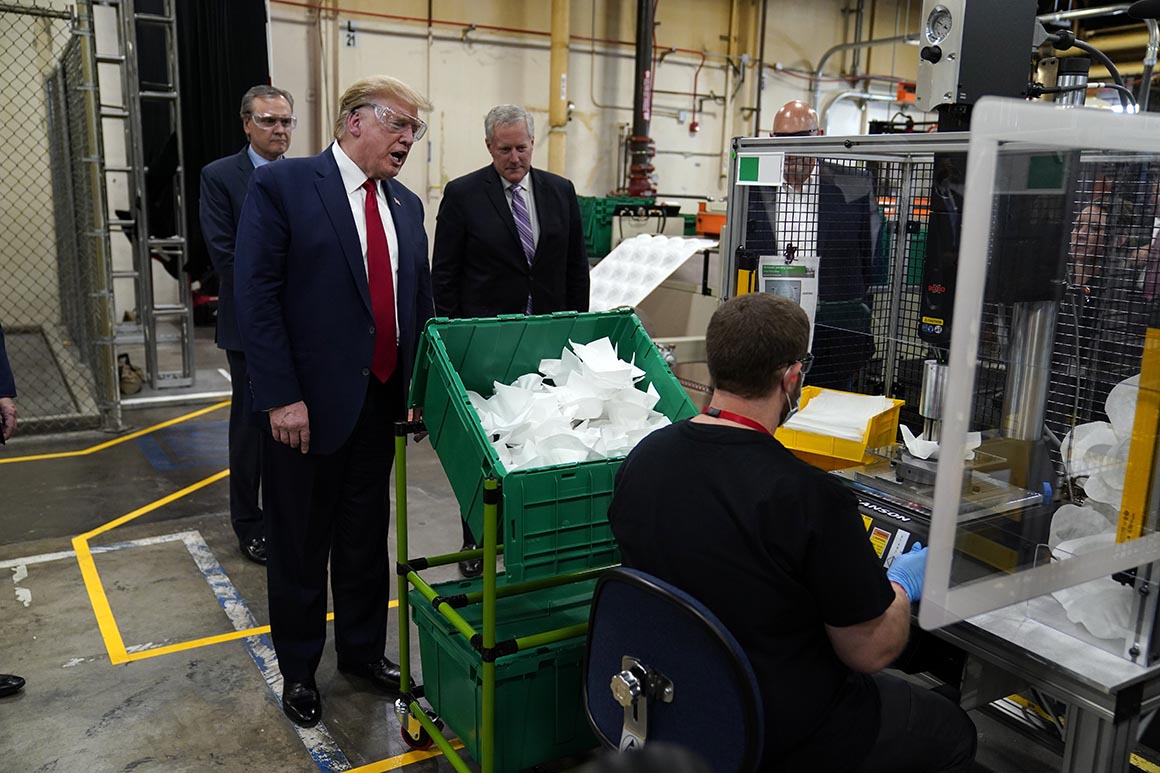
FEMA similarly emphasized to POLITICO that the federal government is pursuing many strategies at once to obtain supplies, and that shortages are not unique to the U.S. An HHS spokesperson said the department has closely coordinated with FEMA and the White House’s coronavirus task force to ensure a „locally executive, state managed, and federally supported response.“
“This is a global pandemic — demand continues to outweigh supply across the globe, not just in the U.S.,” the FEMA spokesperson said. “Considering that, FEMA and HHS are both working hard to ensure federal contracting efforts don’t compete with states’ abilities to acquire PPE and other supplies.”
‘A Massive Undertaking’
Trump and his top officials have touted the nation’s testing ramp-up, stating repeatedly that the U.S. is doing more tests than any other country in the world. On May 1, top Trump health appointee and testing coordinator Brett Giroir joined the interagency group’s meeting to praise an initiative to expand drive-through test sites across the country as a “great success.”
Yet in the days prior, officials cautioned that states trying to test scores of patients were hampered by equipment and gear shortages. Reporting on conversations he’d had with health officials in the mid-Atlantic region, one regional official told the interagency group on April 24 that states’ “supply appears to be the main limiting factor.”
The story was similar among the Northeastern states, an official representing that region concurred.
“Funding and staff is not an inhibitor,” the official said on the same call. “It’s the ability to secure testing supplies and PPE.”
Indeed, while the nation’s testing figures have risen over the last month after lagging for much of February and March, public health experts broadly agree that the U.S. is still not testing enough people to have an accurate picture of the virus’ spread.
The administration was only just beginning to shift its efforts from scrambling to import supplies to trying to boost domestic production of key materials like protective equipment, one official said on May 1, speaking on behalf of an internal task force focused on supply chain issues. Some of those supplies are in demand not just in the health care system, but also by businesses trying to reopen while keeping workers and customers safe.
It was, the official said, “a massive undertaking.”
Participants on that May 1 call — which focused on the theme of “Opening Up America Again” — also spent much of the meeting grappling with the likelihood that as states began to lift their distancing restrictions, new coronavirus outbreaks would follow.
Nearly all of FEMA’s regional teams reported continued increases in both cases and deaths as governors moved to terminate stay-at-home orders, flagging on the calls new hot spots in prisons, meat processing plants, and other high-risk facilities.
At least two states at the time — South Carolina and Georgia — were among those planning to reopen despite logging zero consecutive days of decreasing cases, according to one slide distributed to the group and obtained by POLITICO, much less meeting any of the other basic reopening recommendations or “gates” laid out by the CDC. In Georgia, according to another slide the group saw, new Covid-19 cases were up 65 percent and deaths were up nearly 103 percent over a two-week period.
Trump Praises Reopenings
Trump has vacillated between praising and criticizing Georgia Gov. Brian Kemp’s decision to reopen the state, but on the same day as regional officials expressed concerns in the meeting, the president broadly championed states’ push to reopen.
“I like the states opening. They will be opening,” he said. “They’re going to open safely and quickly, I hope, because we have to get our country back.” Later that week, after widespread blowback to Georgia’s move, including from several Republicans, Trump said Kemp was moving too fast by opening businesses like tattoo parlors and nail salons.
Though some in the administration have publicly acknowledged, and even expressed concern, that states were lifting restrictions before slowing the virus’ spread, the president and his top advisers have largely cheered on the reopening states. They have also suggested that the CDC’s criteria are guidelines, not mandates, that states can use as they see fit.
Health officials in the meantime continued to scramble to stand up new tools to monitor for outbreaks — pulling data from various parts of the government in an attempt, as Redd described it, to “respond to the increased demand and burden on the system” should new clusters of cases pop up. The odds of such virus clusters cropping up, he added, “we of course consider inevitable.”
During that meeting, the officials also confronted a particularly bleak scenario: that the fresh waves of coronavirus cases could threaten once again to overwhelm the nation’s health system.
The U.S. has nearly 104,000 ventilators, according to one slide distributed to the group — of which only about 30,000 were currently in use. Yet while Trump has latched onto that surplus in recent weeks as evidence of the administration’s successful response — dubbing the U.S. “the king of ventilators” — officials on the call were focused on new modeling that predicted yet another ventilator crisis if Americans quickly resumed their pre-pandemic lives.
The model, outlined in a presentation slide obtained by POLITICO, illustrated a worst-case scenario that showed the rash of new cases maxing out and soon exceeding the nation’s ventilator supplies by the first week of June.
The potential crisis was just one of the dangers officials on the call emphasized would require continuous monitoring — and that, despite Trump’s wish for a rapid return to normal, they warned could force the nation back into another damaging lockdown.
“As we lift mitigation, it’s going to be critical to monitor local transmission, public health capacity and health system capacity over time,” one official said on May 1, “and if needed, reinitiate mitigation in the coming weeks.”
Source: politico.com
See more here: news365.stream






